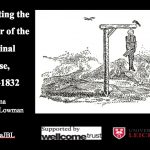
Turned off at Execution Dock: Thames Scenery in the City of the Gallows. By Richard Ward
Eighteenth-century London has, with good reason, been called “the city of the gallows”. Gibbets lined the approach to London in every direction, not least of which at various points along the Thames, where offenders sentenced to death by the High Court of Admiralty for crimes committed on the seas were hung in chains after […]

#SocialHistoryAssociationAnnualConference2016. By Emma Battell Lowman
In late March 2016, the Social History Association (SHA) met for its annual conference. In beautiful Lancaster, at the University of Lancaster, a large group of energetic scholars met to share new research, connect with colleagues, and celebrate four decades of successful operation. This was my first engagement with the Association. I have hesitated […]

Martyrdom, Memory and the Marquis of Montrose. By Rachel Bennett
During the past three years a key part of my research as part of the Criminal Corpse project has been to trace the people who suffered the last punishment of the law from their capital convictions before the criminal courts to their public executions upon the scaffold and the post-mortem fate of their bodies. […]

Getting Away with Murder in Eighteenth Century England. The Surgeon’s Bain and the Power of the Criminal Trial Jury. By Peter King.
The Murder Act of 1752 could have created a major new supply line for the hard-pressed anatomy teachers of England, Wales and Scotland. By making it compulsory for all fully convicted murderers to be not only executed on the gallows, but also either publically dissected or hung in chains on a gibbet, the Act […]

A chance to talk about gibbeting and hanging in France? Yes, please! By Emma Battell Lowman
One of the joys of academic work is participating in study days or workshops that bring together a diverse group of scholars to approach a theme or issue from multiple vantage. It is easy to fall into working within the same networks and groups – whether textually in the form of the bodies of […]

Effigies, Real Bodies and Iconoclasm. By Sarah Tarlow
Last week I was in Chester to examine a PhD thesis there (congratulations to Dr Ruth Nugent – the third person to complete a PhD in the young and dynamic archaeology department there, under the guidance of Howard Williams). As a side note, Howard’s terrific blog, Archaeodeath, is always full of interesting reflections on […]

The Geography of the Criminal Corpse: Magic, therapies and bodily pieces across Europe. By Francesca Matteoni
I have been involved in the first two years of the project as a postdoctoral researcher working on the medico-magical employment of the criminal corpse’s pieces: hands, fingers, blood, corporeal fragments, but even those objects who had a direct contact with the body, such as the rope, or more intangible, mysterious substances like the […]

The Criminal Corpse and the Competing Claims of Justice and Anatomy. By Richard Ward
The later eighteenth century represents a particular moment when the competing claims of anatomy and criminal justice fought for supremacy over the criminal corpse. In both 1786 and 1796, schemes were put before Parliament that sought to extend the 1752 Murder Act by handing surgeons the bodies of offenders executed for a whole range of […]

Dismemberment in Prehistory – Not Just for the Criminally Insane. By Shane McCorristine
For as long as humans have been around we have cut up, hacked, butchered, and mutilated corpses. Today, the practice is mostly associated with serial killers and abnormal personalities. So what is it about post-mortem dismemberment that some people find so shocking and horrifying? This might be a silly question to ask but it is […]
What and When is Death? By Floris Tomasini
In this blog post I’d like to talk about two forms of death, biological and social death, through the conceptual lens of personal identity. This deceptively simple distinction informs a lot of my subsequent conceptual analysis about the harm and redemption of death and dying. It also lays one of the foundation stones for […]

Recent Comments